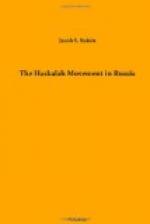But worse things were yet to come, the worst since Chmielnicki’s massacres. The bitterness of both Poles and Russians against the Jews grew especially intense as the days of the rozbior, the Partition of Poland, drew near (1794). The Poles, forgetting the many examples of loyalty and self-sacrifice shown by Jews in times of peace and war, suspected them of being treacherous and unreliable; while the Russians, though denying the patriotism of their own Jews, persisted in the accusation that Polish Jews spent money lavishly in fomenting rebellion and anarchy. The pupils of the Jesuits found great delight in attacks upon the Jews, which frequently culminated in riot and bloodshed and the payment of money by Jews to Catholic institutions. “What appalling spectacles,” exclaims a Christian writer, “must we witness in the capital [Warsaw] on solemn holidays. Students and even adults in noisy mobs assault the Jews, and sometimes beat them with sticks. We have seen a gang waylay a Jew, stop his horses, and strike him till he fell from the wagon. How can we look with indifference on such a survival of barbarism?” The commonest manifestations of hatred and superstition, however, were, as in other countries, the charge that Jews were magicians, using the black art to avenge themselves on their persecutors, and that they used Christian blood for their observance of the Passover. The latter crime, the imputing of which was sternly prohibited by an edict of the liberal Bathory, in 1576, was so frequently laid at their door, that in the short period of sixty years (1700-1760) not less than twenty such accusations were brought against them, ending each time in the massacre of Jews by infuriated mobs. Even more shocking, if possible, was the frequent extermination of whole communities by the brigand bands known as Haidamacks. They added the “Massacre of Uman” (1768) to the Jewish calendar of misfortunes, the most terrible slaughter, equalled, perhaps, only by that of Nemirov in 1648.[5]




